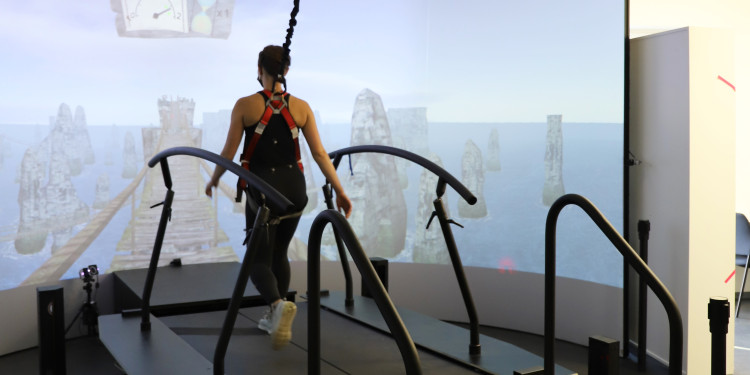
When the feet seem to stick to the floor
In widespread diseases such as diabetes, cancer or Parkinson’s, a significant proportion of research activity is carried out in the fields of medicine or pharmacology. However, other branches of research play an important role in preventing and dealing with everyday symptoms. At the Institute of Sports Science – to be precise, in the Department of Neuromotor Behaviour – research is being done by Prof. Claudia Voelcker-Rehage and her team on the so-called “Freezing of Gait”, which is a temporary gait disorder occurring especially at an advanced stage of Parkinson’s Disease. “Patients suddenly have the feeling that their feet are stuck to the ground – their gait freezes,” Voelcker-Rehage explains. This disorder influences their mobility to a high degree, she says, and can result in falls; and it has a negative impact on the quality of life. The team is carrying out research into the role which sensory stimuli – in the form of vibrating socks – might be able to play in preventing or unlocking the freezing.
The project is an EU cooperation which is being coordinated at the University of Münster. In the project, researchers from the Netherlands and Münster are looking at the question of what triggers the freezing and how it can be prevented. In 2022 the project received the Collaboration Grant awarded by the managements of the Universities of Münster and Twente. “Treatment with medication does not achieve much in the way of lasting success in combating freezing,” adds Voelcker-Rehage. “Cueing seems to be an effective additional measure.” Here, external sensory stimuli (“cues”) are used to initiate or continue a movement. These stimulations can be visual, tactile or acoustic. Studies have shown that a chessboard pattern painted on the floor can help patients to pace their steps better. Acoustic rhythms also serve this purpose. “What helps patients varies from person to person,” says Dr. Robert Stojan from the Münster team. The tactile cueing generated by the vibrating socks has the advantage, he says, that it is neither visible nor audible – and is therefore a very discreet method.
Put in a simple way, the aim with the vibrating socks is that the system learns to recognize the signs of freezing and sends a signal to a small motor. This motor transmits vibrations to the foot. Ideally, this process prevents or unlocks the freezing. “What we aim to do is demonstrate the effectiveness of the socks in realistic scenarios, as well as recognising where improvements can be made – and also find out why freezing happens in the first place,” Stojan explains. So far, it has not been possible to find an explanation for the causes and indicators of freezing – neither in brain research nor in medicine nor in kinesiology. The Münster researchers’ measuring methodology aims to make a contribution to solving the puzzle.
The state-of-the-art equipment in the kinesiology lab depicts situations similar to those encountered in everyday life. Test persons are currently going through a variety of virtual scenarios on a huge, curved 180-degree screen. On the large-scale equipment with the name of GRAIL (Gait Real-time Analysis Interactive Lab), patients walk on a treadmill. An integrated analytical system with high-resolution cameras and force plates enables a detailed analysis of gait and freezing to be made. At the same time, patients’ brain activity is recorded, as are any changes in the oxygen content of the blood in the brain.
The aim is for the vibrating socks to be got ready to be marketed by a company specialising in medical technology. “Even if an actual application of the socks in practice is the overriding aim, what interests us as researchers most of all is what we can learn from a scientific point of view,” says Claudia Voelcker-Rehage. The Münster team is currently making very good progress on its way to gaining a better understanding of freezing. Initial results confirm that the vibrating socks work well in practice and that some of the patients record positive effects on freezing. The team expects final results to be available at the end of the year.
Author: Hanna Dieckmann
This article is from the University newspaper wissen|leben No. 6, 1 October 2025.
